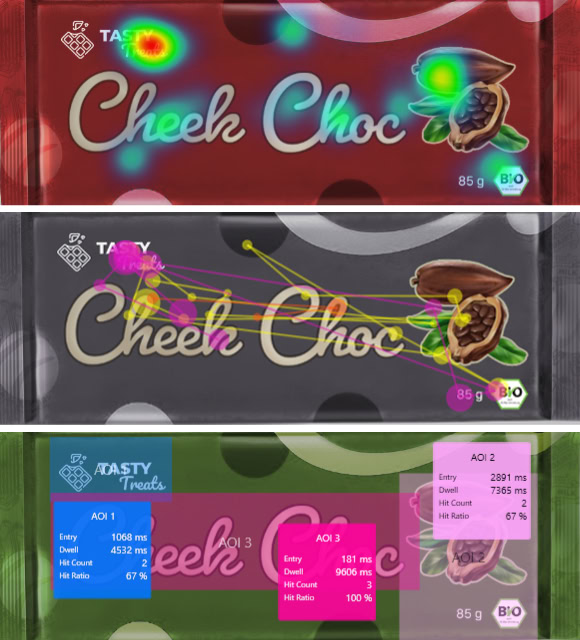02.12.2024
Eye Tracking in Neuromarketing: Unlocking Consumer Insights
 by Mirta Ivanek, Product Manager
by Mirta Ivanek, Product Manager
In today’s competitive marketing landscape, understanding consumer behaviour has become essential for crafting impactful designs. Neuromarketing, an interdisciplinary field combining neuroscience, psychology, and marketing, has emerged as a powerful tool to decode consumer decision-making processes1. Among the techniques used in neuromarketing, eye tracking stands out as a non-invasive yet insightful method to measure visual attention and gaze behavior2.
This blog post explores the role of eye tracking in neuromarketing, its advantages, and its applications across industries, demonstrating why it is shaping the future of advertising.
What is Eye Tracking in Neuromarketing?
Eye tracking is a technology that monitors and records where and for how long a person’s gaze is focused. By using specialized cameras, eye tracking captures eye movements as individuals view marketing stimuli, such as ads, websites, or product packaging.
Neuromarketing researchers analyze key metrics, such as:
- Fixations: points where the eyes pause to gather visual information
- Saccades: quick movements between fixations
- Pupil dilation: an indicator of emotional arousal
These insights help marketers understand which elements capture attention, which are ignored, and how consumers visually navigate a stimulus.
Advantages of Using Eye Tracking in Neuromarketing
Eye tracking offers a range of benefits that make it an essential tool in consumer research:

Objective Measurement
Eye tracking captures real-time behavior without relying on self-reported data, offering a bias-free and precise understanding of consumer reactions.

Actionable Insights
It identifies specific elements – colors, shapes, or text – that attract or repel attention, enabling marketers to refine designs and campaigns.

Enhanced ROI
By optimizing marketing strategies based on eye tracking data, businesses reduce guesswork, improve targeting, and achieve higher returns on investment.

Cross-Industry Application
Eye tracking isn’t limited to retail: industries like automotive, education, and entertainment use it to understand user preferences and enhance user experiences.

Non-Invasive Technique
Participants aren’t required to verbalize their experiences, avoiding potential inaccuracies or biases.

Comprehensive Attention Data
Eye tracking provides detailed metrics like fixation duration, fixation count, time to first fixation, saccade speed, and amplitude, offering insights into cognitive processes involved in perception.

Versatility
It can be used in various environments, from controlled lab studies to real-world retail settings and online platforms.

Multimodal Integration
When combined with surveys or other neuromarketing methods, such as EEG, or GSR, eye tracking delivers a richer understanding of consumer behavior.
Applications of Eye Tracking in Neuromarketing
Eye tracking is widely applied in several areas of marketing, providing specific insights to optimize strategies:
1. Ad Performance Optimization
Eye tracking reveals which elements of an ad attract attention, ensuring that key messages, branding, and product visuals are effectively noticed.
2. Website and UX Design
For e-commerce and digital platforms, eye tracking helps streamline navigation and optimize layouts, ensuring users easily find call-to-action buttons and other critical elements.
3. Product Packaging
Packaging serves as the first interaction point for many consumers. Eye tracking ensures designs are appealing and that essential information, like the product name, is easily noticed.
4. Content Creation
From social media graphics to infographics, eye tracking assists in designing visually compelling content that captures and retains audience attention.
5. Shelf Placement and In-Store Behavior
Retailers use eye tracking to understand how consumers scan shelves, enabling strategic product placements that maximize visibility and sales.
Different data outputs to decode consumer behaviour
Eye tracking in neuromarketing offers a powerful lens into consumer behavior, combining qualitative insights with quantitative precision. The accompanying images illustrate how this technology captures detailed gaze patters, revealing not only where consumers focus their attention but also the sequence and duration of their engagement. Qualitative heatmaps showcase areas of interest, enabling brands to visualize connections with design elements, advertisements, or products. Meanwhile, quantitative data – such as fixation counts, and dwell times – provide measurable metrics to inform decision-making. Together, these visualizations bridge the gap between intuitive appeal and actionable analytics, empowering marketers to craft campaigns that resonate both conceptually and empirically.

Why Eye Tracking is Revolutionizing Neuromarketing
Eye tracking provides a unique window into consumer attention and decision-making processes. Its ability to objectively capture and analyze visual behavior makes it invaluable for marketers looking to optimize strategies and create user-centered designs.
As the saying goes, “The eyes don’t lie.”, eye tracking ensures that marketers not only understand what captures attention but also use that knowledge to craft campaigns that truly resonate with their audience.
Whether refining an ad, optimizing a website, or designing product packaging, eye tracking in neuromarketing is unlocking insights that were one hidden – reshaping the way brands connect with consumers.
Ready to harness the power of eye tracking for your neuromarketing initiatives? Contact us to learn how our cutting-edge eye tracking technology can support your neuromarketing project. Let’s work together to understand your audience better and create experiences that truly resonate!
1
Lee, N., Broderick, A.J., Chamberlain, L. (2007). What is “neuromarketing”? A discussion and agenda for future research. Int. J. Psychophysiol., 63, 199-204.
2
Morin, C. (2011). Neuromarketing: The New Science of Consumer Behavior. Society, 48, 131-135.
